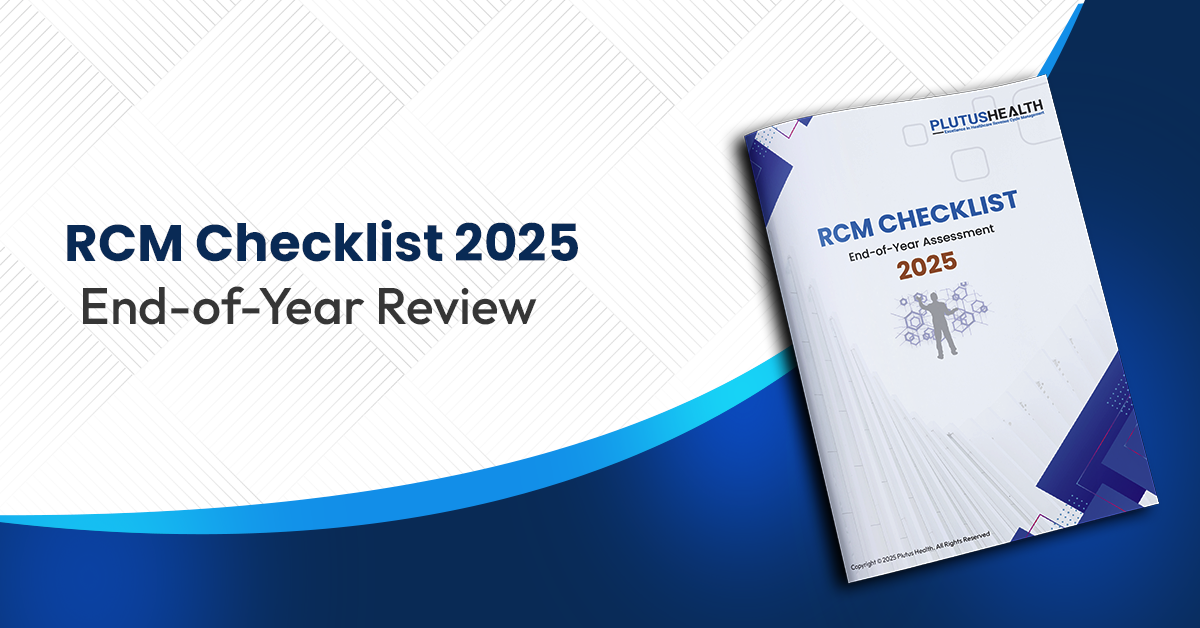How to achieve clean claims in 2024
Claim rejections have been continuously rising over the past couple of years. Healthcare practices and the staff working in the hospital put up immense efforts in submitting a clean claim to avoid payment delays. There are multiple reasons for claim denials, and so are various ways to file clean claims and achieve the first-pass ratio. An industry professional answers all the questions and explains the reason for this trend. You can follow these solutions to get faster payments and minimize your claim denials.
Here is what Thomas, CEO of Plutus Health Inc, with 28 years of experience in Healthcare Revenue Cycle Management, says about the current trends:
Have you observed that the claim rejection rate has increased in the past couple of years?
Claims rejection has increased in the past couple of years because the payers have made it difficult for the providers to get reimbursement. Insurance companies have developed a strict checklist that demands all the checkboxes ticked to get the claim through. Payers monitor all the small details like spelling in the names, DOB, etc. if there is a slight error in it, they reject the claim.
How big is the problem of claim rejection?
The cost of each denial to the healthcare practices or the hospital could be around $15. But every time the claim gets denied, the chances of getting a 100% reimbursement reduces. Collecting the reimbursement after the claim rejection is much tougher. Even the patients cannot be invoiced until the payers have settled the payment. Higher the time between the treatment and the billing. Lower the chances of getting payments from the patients.
What are the ways to ensure that patients pay on time?
The only way to collect payment from the patients on time is by satisfying them and providing an excellent experience. Patients who are satisfied before, during, and after treatment tend to pay the amount on time. The finest way to do this is to invest in patient engagement and provide premium quality services at each point of their interaction, even at the time of collection. If the patients are not satisfied with the billing experience, they will no longer pay and start spreading negative reviews on social media and review websites.
What are the ways to increase patient engagement?
Different practices can engage their patients, such as building an engagement strategy and training their staff accordingly. Understand the billing issues and solve them quickly. If there are only a few errors in the billing, the patients tend to pay faster.
Practice can hire a professional to take care of the patient finance in-house. The staff should be able to track patient satisfaction and provide them services like autopay, payment appointment reminders, or a patient portal. They can even hire a third-party service provider like AnodynePay, who gives optimum solutions for patient engagement and collections.
What are the ways for the healthcare practices to prevent delays or rejections?
The complete billing and claim submission has evolved. The traditional practice of faster claim submission is replaced by accurate claim submission. The professional who submits the claim must be very careful with the documents, as accuracy is the critical element in deciding the acceptance or rejection of the claim. Payers leverage technology like AI to monitor the submitted claims, these tech-enabled systems catch all the minute details and correct them for minimalistic mistakes.
A biller must thoroughly examine the claims before submitting them and must also remove the errors. Providers can also use cutting-edge technologies and automation to increase accuracy. Having a powerful billing system helps to communicate the mistakes to the concerned team and solve them without additional delays.
What are the changes in patient deductibles and copays?
Patients are the toughest when looking to collect payments. They tend to give numerous reasons to deny the payments. The payers now have stopped giving complete reimbursement for the services offered. So, the balance amount needs to be collected from the patients. The billers cannot estimate the exact amount that should be billed to the patients as deductibles and copays unless they get a revert from insurance companies. This waiting period is a significant disadvantage to them. The best time to collect the payment from patients is before the treatment begins, which has now become difficult due to the new policy changes implemented by the healthcare ministry.
What is the importance of team building in patient engagement?
If the claim gets denied, the front desk office staff thinks it is the biller's responsibility. On the other hand, the biller blames the front desk staff for collecting improper patient information. But now, the time has changed. With the boost in telehealth services, patients need not visit the hospital, so the billers need to learn how to check for eligibility verification, and the front desk staff has to assist the biller in collection calls. If the staff member works as a team and assists each other, it can create an excellent environment to enhance the patient experience.
What can practices do to ensure clean claims?
Practices should ensure perfection while submitting the claim. They should use modern technologies and tools to detect and remove errors. Providers should conduct proper claim scrubbing and ask the patients to submit their demographics and insurance information via patient portals. They should always stay active in the market and follow the trends. They should ask the staff to create a detailed business report every week and analyze it to keep improving daily. The report helps in detecting the denial and claim acceptance pattern and trains the software accordingly. More than 50% of errors can be corrected if you crack the claim submission pattern.
Additional Advice to the Practices?
Billers should always be active and alert in the market. They must keep researching the trends and analyse the claim submission pattern to stay in the industry. Staying active will help them in removing all the errors and filing the claim accurately. They will achieve a high first-pass ratio if they follow the above-mentioned steps.
Plutus Health Inc. is the one-stop solution for your medical RCM requirements. It offers excellent claim scrubbing techniques and offer first-pass for all the submitted claims. Plutus Health experts take the necessary steps to file a clean claim and attend a 100% reimbursement in the first submission. The company has achieved the lowest denials in the industry for its clients and tailor the solutions according to the need of the providers.
Clean Claim FAQS
What is Clean Claim?
A claim that is error-free and contains all the information requested by the payer filled promptly. It has all the minute details of the patient and their treatment.
What is the difference between claim rejection and denial?
Rejection is a real-time process that helps to prevent denials. A rejected claim returns to the practices for correction before entering into the payers’ system. It is generally an internal system and is managed by the biller or clearing team. After the error is rectified, it is pushed back for clearance.
The claim that is accepted, reviewed by the payer, and returned with partial or no payment is claim denial. The denied claim can also be resubmitted after making corrections, but it takes months for reimbursement. It demands a lot of cash flow for correction, and the chance of a full refund also is minimum.
State some common medical rejections
Claim rejections happen due to missing codes and type errors in codes. They are also caused by mistakes in patient demographic information.
Stages of claim rejections
Rejected claims go through the providers’ billing system, where the demographic test is done. They next go through the clearinghouse where errors in subscriber id are detected. The final check is done at the payer's end, where the patient eligibility, demographics, coverage, and coding errors are detected.
Plutus Health Inc. is the one-stop solution for your medical RCM requirements. We provide excellent claim scrubbing techniques and offer first-pass for all the submitted claims. We take the necessary steps to file a clean claim and attend a 100% reimbursement in the first submission. We have the lowest denials in the industry and tailor the solutions according to the need of the providers.
Liked the blog? Share it
FAQs


ABA providers are grappling with high staff turnover (up to 65%), rising burnout, administrative overload, and stagnant reimbursement rates. These challenges directly impact care continuity, clinical outcomes, and operational performance.


Operational inefficiency costs ABA teams up to 10 hours per staff member per week, contributing to burnout, denied claims, and longer accounts receivable (A/R) cycles. These inefficiencies ultimately result in reduced revenue and patient dissatisfaction.


Burnout leads to costly turnover, lower client retention, and decreased productivity. Recruiting and replacing a BCBA or RBT can cost up to $5,000 per hire, plus months of lost revenue and disruption to morale.


High-performing ABA organizations invest in clear career pathways for BCBAs and RBTs, align compensation with market benchmarks, and foster peer-led mentorship, flexible schedules, and wellness programs.


Automation tools like Plutus Health's Zeus streamline eligibility verification, denial management, and billing, reducing manual workloads by 5–10 hours weekly per clinician and improving clean claim rates by 95%.


Outsourcing revenue cycle management can improve collections, reduce denials by up to 30%, and free clinicians from billing-related admin tasks, resulting in better client care and financial outcomes.


One $200 million ABA network partnered with Plutus Health to automate eligibility and accounts receivable (A/R) processes. The result: $2M reduction in legacy A/R and a 97% Net Collection Rate.


By improving operational efficiency, investing in technology, and ensuring workforce stability, ABA leaders can align outcomes with reimbursement. Plutus Health supports this transition with scalable RCM and automation strategies.
FAQs


ABA therapy billing is the process of submitting claims to insurance or Medicaid for Applied Behavior Analysis services provided to individuals with autism or developmental disorders. It includes using correct CPT codes, proper documentation, and adherence to payer-specific policies.


Common CPT codes for ABA therapy in 2025 include:
- 97151 – Assessment and treatment planning
- 97153 – Direct therapy with the patient
- 97155 – Supervision and modification of behavior plan
- 97156 – Family adaptive training
- Always check with payers for any annual changes.


To bill Medicaid for ABA services, providers must ensure credentialing is complete, services are pre-authorized, and claims use the correct codes and modifiers. Medicaid requirements vary by state, so always follow state-specific billing rules.


Common ABA billing mistakes include:
- Incorrect or missing CPT codesplan
- Lack of documentation or treatment
- Uncredentialed providers rendering services
- Submitting duplicate or late claims


Without proper credentialing, providers can’t get reimbursed. Insurance and Medicaid require that BCBAs, RBTs, and organizations are credentialed and contracted. Delays in credentialing often cause revenue losses and claim rejections.
FAQs


CMS proposes a 2.4% increase in Medicare ASC payment rates, contingent on meeting ASCQR quality reporting requirements. Plutus Health helps ASCs meet these compliance benchmarks by integrating quality reporting data into RCM workflows, ensuring eligibility for full payment updates.


The ASC Covered Procedures List will expand by 547 procedures, including cardiology, spine, and vascular surgeries. Plutus Health supports expansion into new service lines by customizing RCM processes for high-acuity procedures, minimizing claim denials during the transition.


Site-neutrality narrows the payment gap with hospital outpatient departments, enhancing ASCs' cost-efficiency appeal. Plutus Health helps leverage this advantage in payer negotiations by providing performance dashboards and cost-justification analytics to secure stronger reimbursement terms.


Complex procedures increase denial risk and slow cash flow. Plutus Health's automation-first RCM model delivers 95%+ clean claim rates, reduces A/R days, and safeguards margins, even as your case mix becomes more complex.
FAQs


A hybrid RCM model combines in-house tasks like scheduling, intake, and patient communication with outsourced billing support for claims, denials, and A/R follow-up. Plutus Health enables this model with automation and expert teams.


Frequent CPT code updates, variable session lengths, high no-show rates, and sensitivity around patient collections make behavioral health billing uniquely challenging. Hybrid RCM helps strike a balance between compliance and patient care.


Tasks requiring patient interaction—like intake, eligibility checks, copay collection, and documentation—are best kept in-house, while backend processes can be outsourced.


Outsourcing denial management, claims scrubbing, and payment posting improves clean claim rates, reduces A/R days, and scales capacity without adding staff.


Plutus Health delivers 97%+ clean claim rates, AI-powered denial prediction, and 48-hour claim turnaround. Our hybrid RCM solutions provide behavioral health CFOs with visibility and control, while enhancing financial performance.
FAQs


Payment complexity, high out-of-pocket costs, increasing denials, and value-based care requirements are pushing providers toward more transparent, tech-supported payment systems.


Patients now act like consumers. They expect clear cost estimates, simple bills, digital payment options, and flexible financing.


AI, automation, and digital tools streamline estimates, reduce denials, support payment plans, and allow faster collections through mobile and online payments.


Complex billing questions, insurance confusion, and financial stress require a compassionate approach. Advocates guide patients and protect trust in clinical care.


Plutus Health supports providers with AI-driven denial prevention, predictive analytics, digital payment tools, patient financing, and a seamless platform, such as AnodynePay.


















































